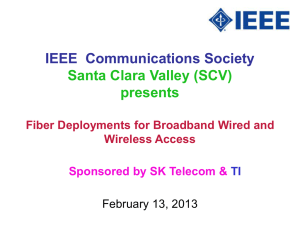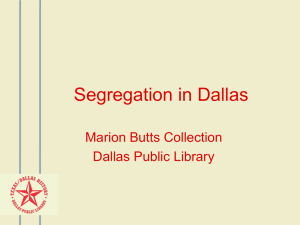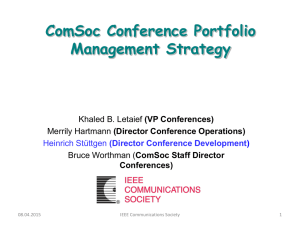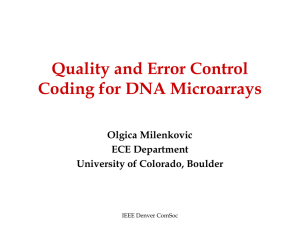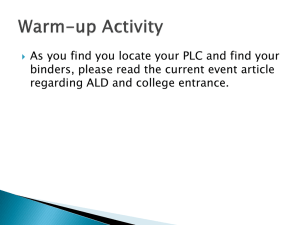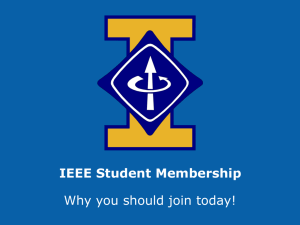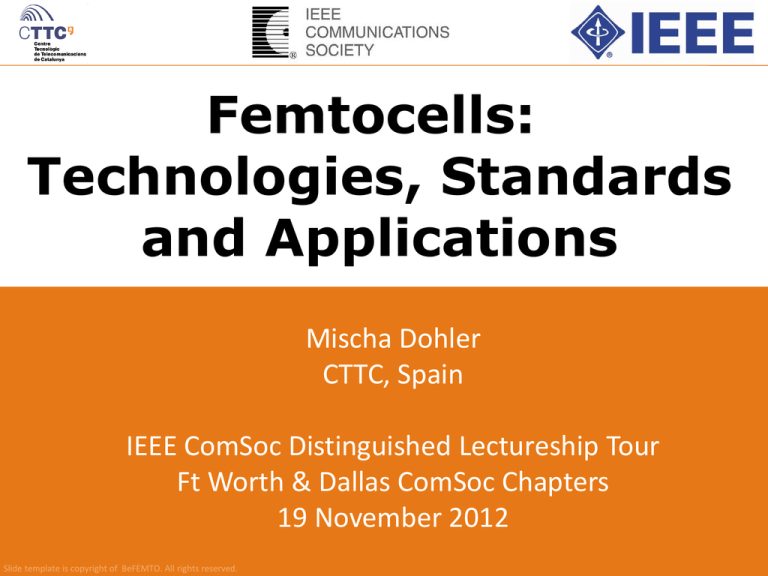
Femtocells:
Technologies, Standards
and Applications
Mischa Dohler
CTTC, Spain
IEEE ComSoc Distinguished Lectureship Tour
Ft Worth & Dallas ComSoc Chapters
19 November 2012
© 2012
MischaisDohler
Slide
template
copyright of BeFEMTO. All rights reserved.
1
IEEE ComSoc Ft Worth & Dallas DLT
Drivers & Vision
© 2012 Mischa Dohler
2
IEEE ComSoc Ft Worth & Dallas DLT
Smartphones Cause Capacity Crunch
home
office
home
80% Indoors
20% Outdoors
© Thierry Lestable, Sagemcom
© 2012 Mischa Dohler
3
IEEE ComSoc Ft Worth & Dallas DLT
The Resulting Capacity Demand Prediction
Total worldwide mobile traffic by 2020:
more than 127 exa-bytes (10^18)
more than 30 times increase compared to today
Total mobile traffic (EB per year)
140.00
Yearly traffic in EB
120.00
100.00
Europe
Americas
80.00
Asia
60.00
Rest of the world
World
40.00
20.00
2010
2015
2020
Source: IDATE
© Thierry Lestable, Sagemcom
© 2012 Mischa Dohler
4
IEEE ComSoc Ft Worth & Dallas DLT
Are we prepared to meet this capacity demand?
IMT-A 4G capacity targets [ITU-R M.2133]:
2.2b/s/Hz for downlink and 1.4b/s/Hz for uplink in urban deployment
supported rate is thus maximal 100Mbps/km2 (500m cell size; 40MHz)
Capacity needs (reality check):
peak density of 8,000 people/Km2
of which only 10% subscribe to the broadband service
of which only 20% require access at the same time
each requiring 5Mbps
8,000 X 10% X 20% X 5Mbps = 800 Mbps/Km2
4G requirements …
… were short by a factor of 10 yesterday
… are short by a factor of 50 today
… will be short by a factor of 100 tomorrow
© 2012 Mischa Dohler
5
City
Average
People/Km2
Athens
5,400
Madrid
5,200
London
5,100
Barcelona
4,850
Warsaw
4,300
Naples
4,100
Berlin
3,750
Paris
3,550
Vienna
3,400
IEEE ComSoc Ft Worth & Dallas DLT
Addressing Capacity Needs in the Past
Increase in capacity over past decades:
Martin Cooper:
overall:
doubled every 30 months over past 100 years
million-fold increase in capacity since 1957
Breakdown of these gains:
5 x PHY; 25 x spectrum; 1600 x reduced cells, 5 x rest
Reduced Cells
MHz
Ratio Gain/Cost
Most Important!
Breakdown of (estimated) cost:
Reduced Cells
MHz
PHY
[HOT - TOP 3 IEEE DOWNLOAD IN APRIL 2011] Mischa Dohler, R.W. Heath Jr., A. Lozano, C. Papadias, R.A. Valenzuela,
"Is the PHY Layer Dead?," IEEE Communications Magazine, vol 49, issue 4, April 2011, pp 159-165.
© 2012 Mischa Dohler
6
IEEE ComSoc Ft Worth & Dallas DLT
Trend confirms: Link-Layer won’t help
© Avneesh Agrawal, Qualcomm
© 2012 Mischa Dohler
7
IEEE ComSoc Ft Worth & Dallas DLT
Time for Major Design Changes
To facilitate the exponential capacity
increase, dramatic changes to how
we design cellular systems are needed!
… oh, and, yes, spectrum is not a problem
and power efficiency neither …
© 2012 Mischa Dohler
8
IEEE ComSoc Ft Worth & Dallas DLT
Going 5G: Change in Design Paradigms
1. Differentiate clearly between outdoors and indoors design
80% of time
20% of time
Similar data experience outdoors & indoors important!
© 2012 Mischa Dohler
9
IEEE ComSoc Ft Worth & Dallas DLT
Going 5G: Change in Design Paradigms
2. Put most efforts on architecture and management thereof
© 2012 Mischa Dohler
10
IEEE ComSoc Ft Worth & Dallas DLT
Going 5G: Change in Design Paradigms
3. Acknowledge heterogeneous nature of wireless arena
© 2012 Mischa Dohler
11
IEEE ComSoc Ft Worth & Dallas DLT
Going 5G: Change in Design Paradigms
4. Use absolute area capacity rather than spectral efficiencies
users care about rates
heterogeneous spectrum use
© 2012 Mischa Dohler
12
IEEE ComSoc Ft Worth & Dallas DLT
Going 5G: Change in Design Paradigms
5. Cost considerations must be taken into account at design phase
© 2012 Mischa Dohler
13
IEEE ComSoc Ft Worth & Dallas DLT
Outline of Talk (all very high-level!)
A. Indoors Femtocell
© 2012 Mischa Dohler
B. Manage Through SON
14
IEEE ComSoc Ft Worth & Dallas DLT
A. Femtocells
© 2012 Mischa Dohler
15
IEEE ComSoc Ft Worth & Dallas DLT
The Small-Cell Solution Space
Only viable solution is via change in architecture & smaller cells:
Remote Radio Head:
Relay:
Pico Cell:
Femto Cell:
“dumb” radio extension of BS; often RF/IF/BB-over-fiber
wireless radio extension of BS; often limited intelligence
intelligent BS; owned, planned and placed by operator
intelligent BS; mostly owned and placed by consumer; no planning!
© Josep Vidal, UPC
© 2012 Mischa Dohler
16
IEEE ComSoc Ft Worth & Dallas DLT
Definition & Differentiation Of Femtocell
Femtocell
Picocell
Wifi
Site Rental
customer
operator
customer
Installation
customer
operator
customer
Electricity Bill
customer
operator
customer
Radio Planning
no (local)
yes (prior & global)
no
Backhaul Connection
via customer
dedicated
via customer
Macrocell Interaction
not (yet)
yes
not applicable
Transmission Power
< 23dBm
23-30dBm
20dBm
mainly closed
public
closed
possible
yes
vertical
Access Rights
Handover
Photo
©Sagem, TID
© 2012 Mischa Dohler
© 3g.co.uk
17
© bandaancha.eu
IEEE ComSoc Ft Worth & Dallas DLT
The Femtocell Opportunity
1. Smart Digital Home:
Microgeneration
3. Allows Traffic Offload:
Comfort
FMC & Multimedia
Security
WiFi
)))
Ethernet
Energy
Health
3G/LTE
ADSL, FTTH, …
© Femto Forum, Thierry Lestable, Sagemcom
© Thierry Lestable, Sagemcom
2. Reduces Customer Churn:
4. Energy Saver For All:
© Mobile VCE, D. Laurenson
© Femto Forum, Thierry Lestable, Sagemcom
© 2012 Mischa Dohler
18
IEEE ComSoc Ft Worth & Dallas DLT
Finding Femtocells Very Appealing
© Femto Forum
© 2012 Mischa Dohler
19
IEEE ComSoc Ft Worth & Dallas DLT
Femtocell Technology Providers
The ecosystem is now mature enough
© Thierry Lestable, Sagemcom
© 2012 Mischa Dohler
20
IEEE ComSoc Ft Worth & Dallas DLT
Femtocell Rollouts & Deployments To-Date
36 commercial deployments in 23 countries
15 roll-out commitments in 2012
© 2012 Mischa Dohler
21
IEEE ComSoc Ft Worth & Dallas DLT
Femtocells Business Model
50£ one off
+5£/month
5$/month
180$ one off
+1.5$/month
10$/month
250$ one
off
free of charge
159$ one off
32$/month
© BeFEMTO
100€ one off
+8€ /month
15€/month
10€/month
199€ one off
255$ one off
+42$/month
In BeFEMTO, four business cases are investigated:
- One off fee: the user pays 50€ once, and the monthly payment does not change (35€/month)
- No fee: the user does not pay for the femtocell, and the monthly payment does not change (35€/month)
- Decrease: the user does not pay for the femtocell, and the monthly payment decreases by 5€ to 30€/month
- Increase: the user does not pay for the femtocell, and the monthly payment increases by 5€ to 40€/month
© 2012 Mischa Dohler
22
IEEE ComSoc Ft Worth & Dallas DLT
Femtocell Market Growth Forecast
© Informa Telecoms & Media
© Thierry Lestable, Sagemcom
© 2012 Mischa Dohler
23
IEEE ComSoc Ft Worth & Dallas DLT
Related Fora & Standards Bodies
Small Cell Forum (before Femto Forum)
not-for-profit, founded 2007, rebranded 2012
manufacturer-driven
main driver behind femtocell uptake
3GPP
IWLAN & EPC standards (for Non-3GPP Access & Mobility)
H(e)NB standards (for Basic FemtoCells)
LIPA & SIPTO standards (for Local Access & Offloading)
ANDSF Standards (for Discovery, Selection & Policy)
LIMONET (for LIPA Mobility), SaMOG(for Trusted WiFi), BBAI (for Broadband Network interworking)
IEEE/WFA/WBA
Hot Spot 2.0 (Discovery & Seamless Access Control)
GSMA
WLAN Task Force (2003?)
WiFi Offload White Paper, April 2010
GSMA-WBA Joint Task Force –WiFi Roaming White Paper, Jan 2012
© Prabhakar Chitrapu, InterDigital
© 2012 Mischa Dohler
24
IEEE ComSoc Ft Worth & Dallas DLT
Femtocell Design Challenges
© BeFEMTO
1. Low Device Cost:
efficient, low-cost power amplifiers, highly sensitive receivers, flexible channel bandwidth, reliable RF
filters; low cost and low power implementation; etc.
2. System Interference Management:
minimize interference to macro (and vice versa); minimize interference to adjacent femtos; coping with
unplanned rollouts; coverage estimation, interference cancellation; etc.
3. Femtocell Capacity Maximization:
link and access management (handover, admission control, resource management, load balancing and
flow control); dynamic bandwidth allocation and sharing; etc.
4. Backhaul Issues:
wired or wireless backhaul, reducing signaling load, QoS provisioning and traffic priorization, joint access
and backhaul design; etc.
5. Viable System Architecture:
control & data planes, access control, authentication, local breakout, efficient forwarding, seamless
mobility, zero-config, etc.
© 2012 Mischa Dohler
25
IEEE ComSoc Ft Worth & Dallas DLT
Problem Of Interference With Femtos
Source: Zubin Bharucha, DOCOMO Euro-Labs
© 2012 Mischa Dohler
26
IEEE ComSoc Ft Worth & Dallas DLT
Rel-10 ICIC In Heterogeneous Networks
To support femtocell deployment effectively, inter-cell interference
coordination (ICIC) is necessary
Different from homogeneous network (macrocell deployments),
o Low power nodes (femto eNBs) must mute (or reduce transmission
power) Named as “Protected resources” here
o High power nodes (macro eNBs) need not mute
o Named as “Non-protected resources” here
Protected/Non-protected resources are multiplexed in frequency or timedomain Both ICIC techniques are effectively supported in Rel-10
Frequency-domain ICIC
Time-domain ICIC
Frequency
Carrier #1
Carrier Carrier
#2
#1
Frequency
Time
Cell layer
Time
Cell layer
Macro layer
Femto layer
Source: Zubin Bharucha, DOCOMO Euro-Labs
© 2012 Mischa Dohler
27
IEEE ComSoc Ft Worth & Dallas DLT
LTE-A Control & Data Frame Structure
• data region interference mitigation (a lot of work with viable solutions)
• control region interference mitigation (surprisingly little work given it is
the actual problem since no control means no data)
Source: Zubin Bharucha, DOCOMO Euro-Labs
© 2012 Mischa Dohler
28
IEEE ComSoc Ft Worth & Dallas DLT
LTE-A Detailed Control Frame Structure
• The control region contains 3 control channels:
– PCFICH: control frame indicator; occurs only on first OFDM symbol;
scattered in frequency domain; indicates size of control region
– PDCCH: downlink control channel; spread in time and frequency;
carries scheduling information
– PHICH: HARQ indicator channel; spread in time and frequency;
contains HARQ information
• Focus on the performance of the first two because of differences in their
distribution patterns – the PCFICH has restricted positions in the time
domain, whereas the PDCCH is dispersed in the time and frequency
domains
Source: Zubin Bharucha, DOCOMO Euro-Labs
© 2012 Mischa Dohler
29
IEEE ComSoc Ft Worth & Dallas DLT
LTE-A Control Interference - Current Approaches
(a)
•No coordination
Heavy
interference on 2
OFDM symbols
Source: Zubin Bharucha, DOCOMO Euro-Labs
© 2012 Mischa Dohler
(b)
• Femto
control
channel sparseness
Interference to
first OFDM symbol
is lowered
30
(c)
•Almost blank subframe
Only interference from
reference symbol
Femto data transmission
is not allowed
IEEE ComSoc Ft Worth & Dallas DLT
Novel Femto-Macro ICIC Approach [1/4]
The proposal from DoCoMo Euro-Labs advocates carefully selecting the Physical
Cell Identifier (PCI) of HeNBs at start-up, such that any interference caused by their
control channels to the PCFICH of any trapped macro UEs is avoided.
o In order for this to be possible, the HeNB needs to identify the eNB that it is
closest to.
Identifying the eNB means that the HeNB must be aware of the PCI of the eNB
(decoded using synchronization procedure).
Source: Zubin Bharucha, DOCOMO Euro-Labs
© 2012 Mischa Dohler
Illustration only
31
IEEE ComSoc Ft Worth & Dallas DLT
Novel Femto-Macro ICIC Approach [4/4]
Qualcomm Proposition in BeFEMTO for Resource Partitioning in Space for Femto-Macro
Interference Mitigation:
Problem Statement:
proper resource partitioning is a must to handle femto-macro interference
beam selection in MIMO-enabled femto BS equipment could be made use of
Innovative Proposition:
design of suitable coordinated beam selection algorithm following LTE codebook designs
comparative study between different restriction and codebook policies
study outcomes: codebook restrictions yields gains to macro users at low femto capacity loss
50% improvement
@ macro
5% deterioration
@ femto
Source: Qualcomm, BeFEMTO
© 2012 Mischa Dohler
32
IEEE ComSoc Ft Worth & Dallas DLT
B. Self-Organizing Networking
© 2012 Mischa Dohler
33
IEEE ComSoc Ft Worth & Dallas DLT
Capacity-Optimal Schedule?
With femtocells, the degrees-of-freedom (DOF)
increase significantly – and with it complexity!
© 2012 Mischa Dohler
[presented by Interdigital: Globecom’11 – IWM2M, Houston]
34
IEEE ComSoc Ft Worth & Dallas DLT
System Degrees of Freedom
High number of femtos/users/resources/etc +
interference constraints -> Problem of DOF
Degrees of Freedom (DOF) / Area:
new system DOF = old system DOF
new system density = old system density
new DOF/km2 = old DOF/km2
© 2012 Mischa Dohler
35
x 20-30
x4
x 100
IEEE ComSoc Ft Worth & Dallas DLT
SON Is The Only Solution
SON Helps For Previously Manual Processes:
reduce manual intervention for deployment savings
automate repetitive processes
examples: automatic planning & self-configuration
SON Helps For Too Fast/Complex Processes:
improve run-time operation based on real-time data
automate optimization of critical network elements
example: self-optimization & self-healing
Among the many possible approaches, we deal with
cognitive/docitive RRM to facilitate SON.
© 2012 Mischa Dohler
36
IEEE ComSoc Ft Worth & Dallas DLT
SON In Cellular Networks
© 2012 Mischa Dohler
37
IEEE ComSoc Ft Worth & Dallas DLT
Important SON Tradeoffs
© 2012 Mischa Dohler
38
IEEE ComSoc Ft Worth & Dallas DLT
SON Through Cognition/Docition
From cognitive to docitive networking paradigms:
cognition: “system which is working under conditions it was not designed for”
docition: “teaching” between expert nodes to accelerate learning/cognition
result: truly autonomous SON with quick convergence
© 2012 Mischa Dohler
39
IEEE ComSoc Ft Worth & Dallas DLT
Cognitive Approach – Q-Learning
FOR each (s, a) DO
Initialize table entry:
Q( s , a ) 0
a1 p1
...
al pl
Observe current state s
s1
Q ( s1 , a1 )
WHILE (true) DO
s2
Q ( s2 , a1 )
...
Q(s2 , a * )
...
Q ( s 2 , al )
Q (v , a1 )
...
Q (v, a * )
...
Q (v, a l )
...
Select action a and execute it
Q ( s1 , al )
Receive immediate cost c
Observe new state v
v
Update table entry for Q(s,a) as
...
follows
Q( s, a) Q( s, a) [c max Q(v, a) Q( s, a)]
a
sk
Q ( sk , a1 )
Q ( s k , al )
State transition from s to v
© 2012 Mischa Dohler
40
IEEE ComSoc Ft Worth & Dallas DLT
Docition Approach – Exchange of Q-Entries
Nodes operate in a distributed and autonomous fashion but
exchange suitable parts of their Q-Table:
Output Action
pxy
Input State
Startup Docition. Docitive femto BSs teach their policies to
newcomers joining the network.
IQ-Driven Docition. Docitive radios periodically share part of
their policies with less expert nodes with similar gradient.
© 2012 Mischa Dohler
41
IEEE ComSoc Ft Worth & Dallas DLT
Performance – Superior Capacity
Macrocell capacity as function of femtocell density:
© 2012 Mischa Dohler
42
IEEE ComSoc Ft Worth & Dallas DLT
Performance – Superior Convergence Precision
CCDF of average SINR at macrouser for a 50 % occupation ratio:
© 2012 Mischa Dohler
43
IEEE ComSoc Ft Worth & Dallas DLT
Performance – Superior Convergence Speed
Convergence speed improves by order of magnitude from
20,000 (cognitive) to 4,000 (docitive) iterations:
© 2012 Mischa Dohler
44
IEEE ComSoc Ft Worth & Dallas DLT
C. Future Challenges
© 2012 Mischa Dohler
45
IEEE ComSoc Ft Worth & Dallas DLT
Conclusions on Femto Cells
Heterogeneity Is Quickly Increasing:
femtos, networked femtos, wifi, m2m, etc, etc
future use outdoors, mobile, in relay form
allow for viable QoS/QoE delivery
Self-Organizing Networking Will Be Key:
distributed localized SON (important for signaling)
standards compliant SON approaches for industry uptake
take energy constraints into account
Business Models
subscriber models
FON-like approaches
© 2012 Mischa Dohler
46
IEEE ComSoc Ft Worth & Dallas DLT
Conclusions on Femto Cells
Femtocell rollouts of the future:
Data Traffic:
40% @Home
35% On the Move
25% Work
© BeFEMTO & Thierry Lestable, Sagemcom
© 2012 Mischa Dohler
47
IEEE ComSoc Ft Worth & Dallas DLT

